|
Zoothera gurneyi (Orange
ground-thrush,
Orange thrush)
Oranjelyster [Afrikaans]; Gurney-lijster [Dutch]; Grive de
Gurney [French]; Gurneys grunddrossel [German]; Tordo-da-terra-laranja
[Portuguese]
Life
> Eukaryotes >
Opisthokonta
> Metazoa (animals) >
Bilateria >
Deuterostomia > Chordata >
Craniata > Vertebrata (vertebrates) > Gnathostomata (jawed
vertebrates) > Teleostomi (teleost fish) > Osteichthyes (bony fish) > Class:
Sarcopterygii (lobe-finned
fish) > Stegocephalia (terrestrial
vertebrates) > Tetrapoda
(four-legged vertebrates) > Reptiliomorpha > Amniota >
Reptilia (reptiles) >
Romeriida > Diapsida > Archosauromorpha > Archosauria >
Dinosauria
(dinosaurs) > Saurischia > Theropoda (bipedal predatory dinosaurs) >
Coelurosauria > Maniraptora > Aves
(birds) > Order: Passeriformes
> Family: Muscicapidae > Genus: Zoothera
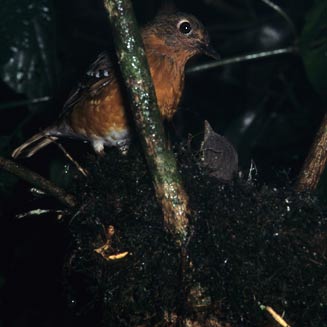 |
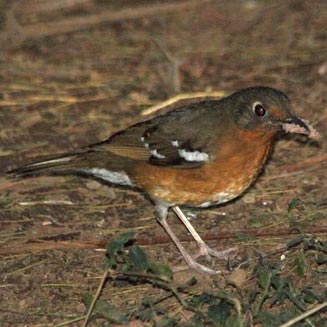 |
|
Orange ground-thrush at nest with chick. [photo
Peter Steyn ©] |
Orange ground-thrush, Benvie Farm, KwaZulu-Natal,
South Africa. [photo
Alan Manson
©] |
For information about this species, see
www.birdforum.net/opus/Orange_Ground-Thrush Distribution and habitat
Occurs in scattered populations from Kenya through
Tanzania, Malawi, Zambia and Mozambique to southern Africa. Here it is generally
uncommon in moist Afromontane evergreen forest along the escarpment of eastern
and southern South Africa (also in Zimbabwe's eastern highlands), especially
along perennial streams in deeply incised drainage lines.
|
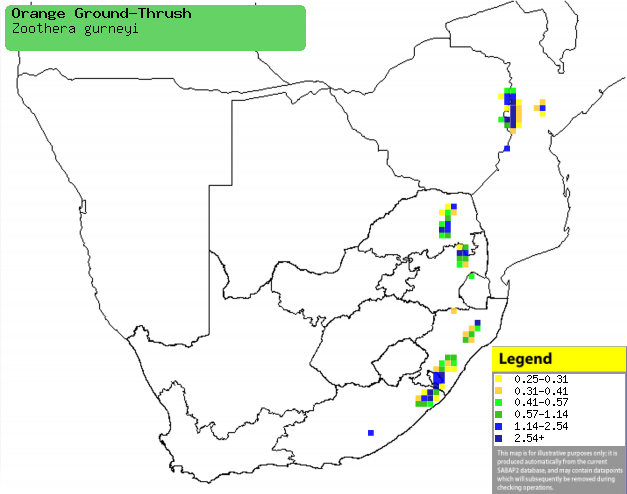 |
|
Distribution of Orange ground-thrush in southern Africa,
based on statistical smoothing of the records from first SA Bird Atlas
Project (©
Animal Demography unit, University of
Cape Town; smoothing by Birgit Erni and Francesca Little). Colours range
from dark blue (most common) through to yellow (least common).
See here for the latest distribution
from the SABAP2. |
Food
It mainly eats invertebrates, especially earthworms,
supplemented with berries and other fruit. It does most of its foraging on
carpets of leaf litter, plucking food from the ground and from beneath rotting
logs, also taking prey flushed by a mound-building mole-rat (Cryptomys). The following food items have been recorded
in its diet:
- Invertebrates
- earthworms
- arthropods occurring in leaf litter
- small moluscs
- Fruit (such as berries)
Breeding
 |
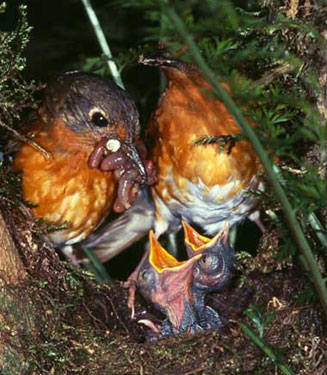 |
| Orange ground-thrush parents feeding
the young chicks, Nkandla Forest, KwaZulu-Natal, South Africa. [photo
Guy Upfold ©] |
They mainly feed the young earthworms, as shown
in this picture. [photo
Hugh Chittenden ©] |
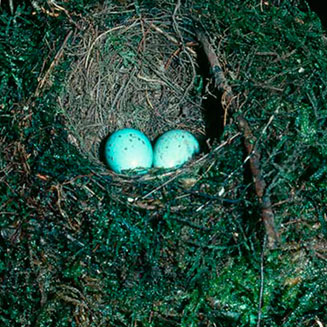 |
 |
| Orange ground-thrush eggs, Nkandla
Forest, KwaZulu-Natal, South Africa [photo
Hugh Chittenden ©] |
Female Orange ground-thrush brooding the chicks,
Nkandla Forest, KwaZulu-Natal, South Africa. [photo
Guy Upfold ©] |
- The nest (see images above) is an untidy open cup built of dead leaves and
the fronds of small ferns and covered in green moss. The interior is often
lined with black rootlets, or more occasionally with the green leaf fronds
of Asparagus. It is typically placed on a horizontal branch or fork
in an understorey shrub or bush, but it may also position it against a tree
trunk supported by vines, in a vegetated bank or road cutting, a hollow in a
gully wall or on the crown of a tree fern.
- Egg-laying season is from October-January.
- It lays 1-3, usually 2 eggs, which are incubated solely by the female
for about 15 days.
- The chicks are brooded by the female on misty or wet days (which are
frequent in escarpment forest), meaning that the male does most of the
foraging, mainly feeding the young on earthworms. The chicks eventually
leave the nest after about 15-19 days, after which they are still dependent
on their parents for an unknown period of time.
Threats
Not threatened globally, but Near-threatened in
southern Africa, largely due to fragmentation of Afromontane forest in South
Africa, caused by clearing, deforestation and illegal cultivation of Cannabis (Cannabis
sativa)
References
-
Hockey PAR, Dean WRJ and Ryan PG 2005. Roberts
- Birds of southern Africa, VIIth ed. The Trustees of the John Voelcker
Bird Book Fund, Cape Town.
-
Harrison, J.A., Allan, D.G., Underhill, L.G., Herremans, M.,
Tree. A.J., Parker, V. & Brown, C.J. (eds). 1997. The atlas of southern
African birds. Vol. 2: Passerines. BirdLife South Africa, Johannesburg.
|
